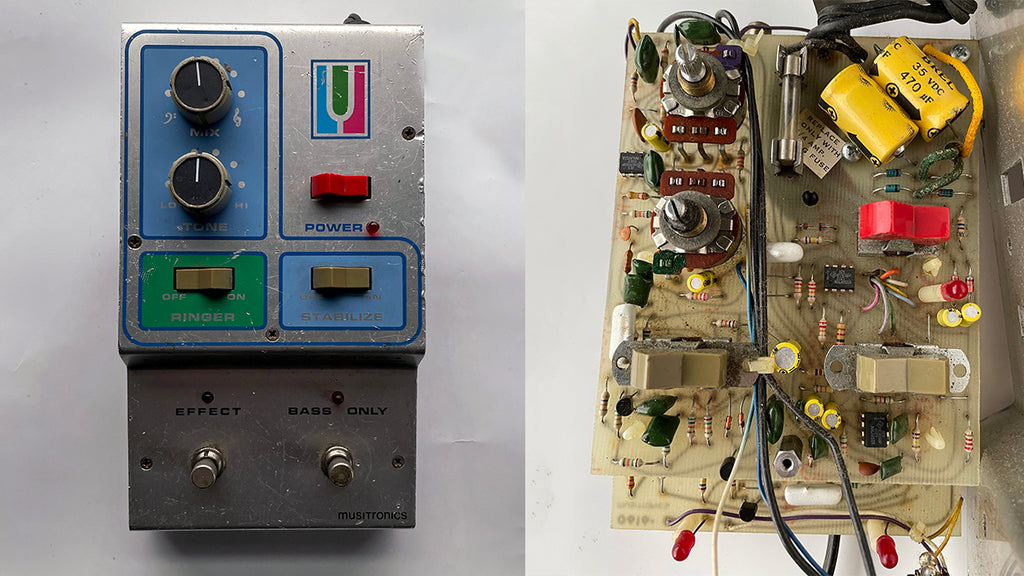Mu-Tron Octave Divider

While the Cabinet is filled with a ton of pedals that we love playing from time to time, its primary function is less of a toy box and more of a perpetual inspiration machine. Many of these are of significant historical importance, many that are innovative scions of the great inventors dotting the pedal timeline, and many just plain sound awesome. Some tick all three boxes. One of them is the Mu-Tron Octave Divider.
Ask a casual pedal fan to name 25 pedal companies and Mu-Tron probably won’t be in the list. But the brains behind the operation, Mike Beigel, brought a huge degree of metamorphosis to the industry and crafted a pedal line that stripped some of the unitaskery and gimmickry from pedals and turned them into intuitive performance tools.
Originally tasked with designing a synthesizer system for Guild, Beigel and some associates from MIT had their contract annulled when the person in charge of brokering the deal died in a plane crash and his replacement viewed the project as less favorable. Beigel decided to part out the synth idea and start his own company with an engineer from Guild, which he called Musitronics, collectively known as Mu-Tron.
As is to be expected, the synth’s filter was the first to enter the market in 1972, called the III, and needing no more explanation as one of the most groundbreaking effects in pedal history. But several other effects came after, such as three phasers (one of which is the most expensive phaser of all time), a wah, a flanger, and the Octave Divider.
The Octave Divider is of particular note, because it was a particularly high-profile collaboration between two industry heavy hitters—Beigel and George Merriman, formerly of Dan Armstrong. The Armstrong influence on the design was particularly prominent, as I’ll explain in a second.
For a pedal that was released in the mid-’70s in rather limited quantities, the Octave Divider sure had a wild variance of devotees. Jeff Beck famously uses one in his solo shows, as did Jerry Garcia, a player particularly taken with Mu-Tron’s wares. Larry Graham of Sly & the Family Stone loved his so much that he nicknamed it “Bigfoot,” because he claimed it made his bass tone sound like “someone with a size 29 shoe” stomping around. Players like Neil Young, Larry LaLonde of Primus and Tim O’Brien from Cannibal Corpse all used one to great effect in wildly different genres.
One of the only effects to utilize a dual footswitch design, the Octave Divider was a winner both in tone and performance. Players could dial in a two-voice harmony with the mix control, then use a footswitch to entirely kill the dry signal for a massive, bowel-quaking sub octave. If you’re the type that likes a little extra character in your soloing, a “stabilize” switch firms up the tracking or plays fast and loose with the root notes.
One of the biggest additions was one of Merriman’s contributions that turned the Octave Divider into a full-on Mu-tron-Armstrong supercut: the addition of another incredibly groundbreaking addition, previously only available in plug-in form, the Green Ringer. This circuit is one of the cleanest octave-up circuits around, contains no adjustable parameters of any kind and came to be a wonderful addition to any circuit that desperately needed some extra pepper. Frank Zappa had a raw Ringer PCB hard-wired into every guitar he owned. He also used an Octave Divider; the man just couldn’t get enough Ringer in his life.
The actual schematic is a work of art, featuring a host of familiar and unfamiliar bits and bobbins. In a world where the player is forced to reckon with schematic familiarity and the lines between player and tinkerer are blurred, players in the year 2020 are familiar with well-trodden circuit topology. In other words, Fuzz Faces and Tube Screamers are easily picked apart even without any formal training.
Like Tom Oberheim’s designs that I’ve discussed prior, Beigel’s work defies any convention past or present, all the way down to a simple tone control. The schematic is therefore extremely dialed-in and beyond any external modification barring a total overhaul. Which Beigel did when he rebooted the line. Mike Beigel’s contributions to the craft can not be overlooked and his work is something I’m proud to have in the Cabinet.
